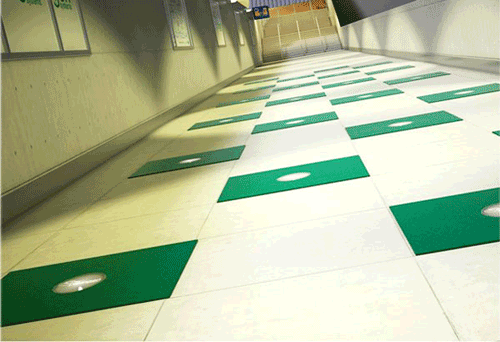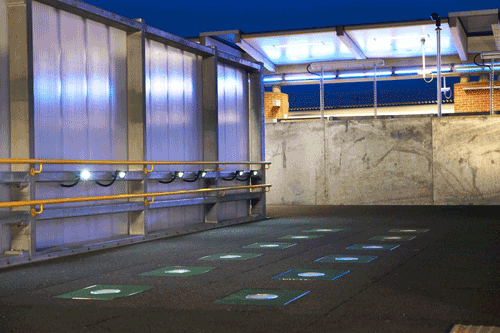New technology uses footsteps to turn on the lights
Kickstarter project bases power generation off footsteps taken
BY MELISSA SUE SORRELLS GALLEY
London-based entrepreneur Laurence Kemball-Cook plans to change the world one step at a time. Literally. His company, Pavegen, has created a technology that harvests energy from individual footfalls.

Pavegen tiles harvest electricity from footfalls
The idea is simple: each time someone walks over one of the 17.7-by-23.6-inch tiles, it flexes a slight 5 millimeters, capturing the kinetic energy and converting it to electricity. The energy harvested can immediately drive low-power applications like lighting and signage, or be stored in an on-board battery for about three days.
With the need to minimize our carbon footprint growing, Pavegen offers an interactive way for people to engage with sustainability. In addition to harvesting clean power sustainably, the tiles themselves are almost completely made from recycled materials — making them even more eco-friendly. Top surface is 100% recycled rubber from tires, while the base is made from more than 80% recycled materials.
Kembell-Cook originally developed the idea while working on his industrial design degree at Loughborough University. Assigned to look into solar and wind energy prospects in urban areas, he realized that it would be more suitable to take advantage of power being generated on the ground.
Applications
The tiles are designed for use in harsh outdoor locations and well-trafficked urban environments, like pedestrian malls, city streets and transportation hubs. In addition to being completely waterproof, they can either be installed in pre-existing flooring systems or included in new developments.
Nearly 30 projects have been installed throughout Europe, including a recent 12-tile installation on a walkway that connects the West Ham tube station to The Queen Elizabeth Olympic Park in London. Over the course of the Games, the tiles experienced nearly 1 million footsteps and generated 20 kilowatt-hours of energy, enough to keep streetlamps at full power throughout the night.

12 energy-harvesting tiles line a walkway near Olympic Park.
The tiles have also been installed in schools throughout London. Since 2010, four Pavegen tiles have lined a hallway at the Simon Langton Grammar School for Boys near Canterbury, capturing energy from its 1,100 students to keep the corridor lit. At another school in Kent, 50% of the electricity generated is used to power fun, interactive and educational displays in the hallway, while the other half is used to light the hallway.
“The product itself has been a delight and has captured the imagination of our students,” says Ken Moffat, head of school at Simon Langton School. “It is robust enough to withstand the constant footfall and attention of over 1,000 students and has generated a significant amount of energy”
The technology also has applications as a lighted dance floor and a people-powered mobile phone charger. During one temporary installation of the tiles, 250,000 steps were enough to charge 10,000 mobile phones.
Kickstarter Campaign
The company currently has a Kickstarter project to fully fund Pavegen installations in two schools: one in the U.S. and one in the U.K. In addition to installing the tiles and interactive educational displays, the company will also install remote monitoring equipment, designed to collect and share data about the output and performance of the technology. Running until January 28, the campaign allows backers to vote for the winning schools.

Students walk down a hall powered by Pavegen tiles.
The Future of Pavegen
Currently, the team is working on a system that will connect the tiles to an electrical grid, and while mechanical tests suggest that the tiles will last at least five years, the team would like to come up with a version that can survive in the wild for at least 20 years.
Of course, pricing is a factor. So far, early versions of the tiles have been prohibitively high for the common consumer, but Kemball-Cook says that the price has dropped 70 percent in the past year. He’s confident that once the company reaches a tipping point and economies of scale kick in, the tiles will sell for as low as $50 each.
The average person takes 200 million steps in a lifetime. What will you power with yours?
To learn more about Pavegen, visit the Pavegen website or their Kickstarter page. ■
Advertisement
Learn more about Electronic Products Magazine





